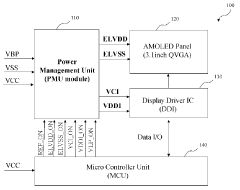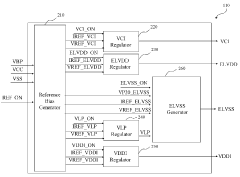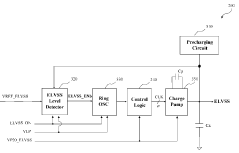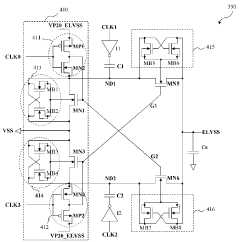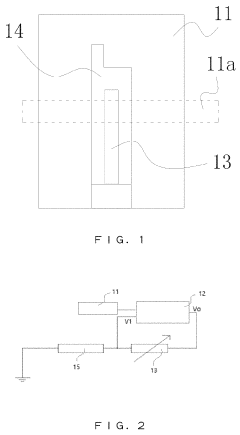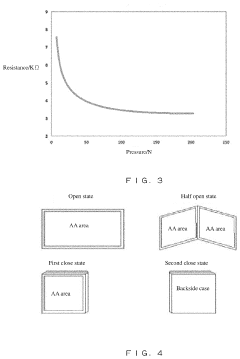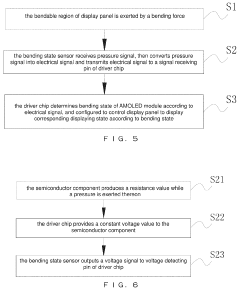How AMOLED supports customization in consumer devices?
JUL 17, 20259 MIN READ
Generate Your Research Report Instantly with AI Agent
Patsnap Eureka helps you evaluate technical feasibility & market potential.
AMOLED Customization Evolution
The evolution of AMOLED customization in consumer devices has been a remarkable journey, driven by technological advancements and changing consumer preferences. Initially, AMOLED displays were primarily used in high-end smartphones, offering vibrant colors and deep blacks. As the technology matured, its application expanded to various consumer devices, including smartwatches, tablets, and even televisions.
The early stages of AMOLED customization focused on enhancing display quality and energy efficiency. Manufacturers experimented with different pixel arrangements and subpixel layouts to improve resolution and reduce power consumption. This led to the development of PenTile matrix subpixel layouts, which became a standard in many AMOLED displays.
As the technology progressed, customization efforts shifted towards flexibility and form factor innovation. The introduction of flexible AMOLED displays marked a significant milestone, enabling the creation of curved and foldable devices. This breakthrough opened up new possibilities for device design and user interaction, leading to the development of smartphones with curved edges and foldable tablets.
Color accuracy and brightness became key areas of focus in the mid-2010s. Manufacturers invested heavily in color management technologies, introducing features like HDR support and wide color gamuts. This allowed for more accurate color reproduction and enhanced visual experiences across different types of content.
The next phase of AMOLED customization centered on integration with other device components. Under-display fingerprint sensors and front-facing cameras became possible, thanks to advancements in AMOLED technology. This integration allowed for sleeker device designs and improved screen-to-body ratios.
Recent developments in AMOLED customization have focused on enhancing refresh rates and touch responsiveness. High refresh rate displays, some reaching up to 120Hz or even 144Hz, have become increasingly common in premium smartphones and gaming devices. These improvements have significantly enhanced the smoothness of animations and touch interactions.
The latest frontier in AMOLED customization involves variable refresh rate technology and advanced power management features. These innovations allow devices to dynamically adjust their display characteristics based on content and usage patterns, further improving energy efficiency and user experience.
Looking ahead, the future of AMOLED customization is likely to involve advancements in micro-LED integration, further improvements in flexibility, and the development of transparent displays. These innovations promise to expand the range of applications for AMOLED technology beyond traditional consumer devices, potentially revolutionizing fields such as augmented reality and smart home technologies.
The early stages of AMOLED customization focused on enhancing display quality and energy efficiency. Manufacturers experimented with different pixel arrangements and subpixel layouts to improve resolution and reduce power consumption. This led to the development of PenTile matrix subpixel layouts, which became a standard in many AMOLED displays.
As the technology progressed, customization efforts shifted towards flexibility and form factor innovation. The introduction of flexible AMOLED displays marked a significant milestone, enabling the creation of curved and foldable devices. This breakthrough opened up new possibilities for device design and user interaction, leading to the development of smartphones with curved edges and foldable tablets.
Color accuracy and brightness became key areas of focus in the mid-2010s. Manufacturers invested heavily in color management technologies, introducing features like HDR support and wide color gamuts. This allowed for more accurate color reproduction and enhanced visual experiences across different types of content.
The next phase of AMOLED customization centered on integration with other device components. Under-display fingerprint sensors and front-facing cameras became possible, thanks to advancements in AMOLED technology. This integration allowed for sleeker device designs and improved screen-to-body ratios.
Recent developments in AMOLED customization have focused on enhancing refresh rates and touch responsiveness. High refresh rate displays, some reaching up to 120Hz or even 144Hz, have become increasingly common in premium smartphones and gaming devices. These improvements have significantly enhanced the smoothness of animations and touch interactions.
The latest frontier in AMOLED customization involves variable refresh rate technology and advanced power management features. These innovations allow devices to dynamically adjust their display characteristics based on content and usage patterns, further improving energy efficiency and user experience.
Looking ahead, the future of AMOLED customization is likely to involve advancements in micro-LED integration, further improvements in flexibility, and the development of transparent displays. These innovations promise to expand the range of applications for AMOLED technology beyond traditional consumer devices, potentially revolutionizing fields such as augmented reality and smart home technologies.
Consumer Device Market Trends
The consumer device market has witnessed significant shifts in recent years, driven by technological advancements and changing consumer preferences. AMOLED (Active-Matrix Organic Light-Emitting Diode) technology has emerged as a key player in this evolving landscape, offering unprecedented opportunities for customization in consumer devices.
The smartphone segment, which dominates the consumer device market, has been at the forefront of AMOLED adoption. As consumers increasingly demand devices with superior display quality, longer battery life, and innovative form factors, AMOLED screens have become a differentiating factor for manufacturers. The technology's ability to deliver vibrant colors, deep blacks, and high contrast ratios has made it particularly attractive for high-end and flagship devices.
Wearable technology, another rapidly growing segment, has also embraced AMOLED displays. Smartwatches and fitness trackers benefit from AMOLED's energy efficiency and flexibility, allowing for curved screens and always-on displays without significant battery drain. This has enabled manufacturers to create more aesthetically pleasing and functional wearable devices, catering to both fashion-conscious consumers and tech enthusiasts.
The television market has seen a gradual shift towards OLED and AMOLED technologies, particularly in the premium segment. Consumers are increasingly willing to invest in high-quality displays for their home entertainment systems, driving demand for large-screen AMOLED TVs that offer superior picture quality and thinner profiles compared to traditional LED-LCD models.
In the automotive sector, AMOLED displays are gaining traction for in-vehicle infotainment systems and digital dashboards. The technology's ability to produce curved and flexible displays allows for more ergonomic and visually appealing interior designs, aligning with the trend towards more connected and technologically advanced vehicles.
The gaming industry has also recognized the potential of AMOLED technology. Gaming smartphones and handheld consoles with AMOLED screens offer enhanced visual experiences, with faster refresh rates and better color reproduction, catering to the demands of serious gamers for immersive gameplay.
As consumer devices continue to evolve, the trend towards personalization and unique user experiences is becoming more pronounced. AMOLED technology's inherent flexibility in terms of form factor and display characteristics positions it as an enabler for this customization trend. Manufacturers are exploring foldable and rollable devices, leveraging AMOLED's pliability to create innovative form factors that blur the lines between smartphones, tablets, and laptops.
The market trends indicate a growing consumer appetite for devices that not only perform well but also offer unique aesthetic and functional features. AMOLED's ability to support customization in terms of color accuracy, power efficiency, and form factor flexibility aligns well with these evolving consumer preferences, suggesting a continued strong presence in the consumer device market for the foreseeable future.
The smartphone segment, which dominates the consumer device market, has been at the forefront of AMOLED adoption. As consumers increasingly demand devices with superior display quality, longer battery life, and innovative form factors, AMOLED screens have become a differentiating factor for manufacturers. The technology's ability to deliver vibrant colors, deep blacks, and high contrast ratios has made it particularly attractive for high-end and flagship devices.
Wearable technology, another rapidly growing segment, has also embraced AMOLED displays. Smartwatches and fitness trackers benefit from AMOLED's energy efficiency and flexibility, allowing for curved screens and always-on displays without significant battery drain. This has enabled manufacturers to create more aesthetically pleasing and functional wearable devices, catering to both fashion-conscious consumers and tech enthusiasts.
The television market has seen a gradual shift towards OLED and AMOLED technologies, particularly in the premium segment. Consumers are increasingly willing to invest in high-quality displays for their home entertainment systems, driving demand for large-screen AMOLED TVs that offer superior picture quality and thinner profiles compared to traditional LED-LCD models.
In the automotive sector, AMOLED displays are gaining traction for in-vehicle infotainment systems and digital dashboards. The technology's ability to produce curved and flexible displays allows for more ergonomic and visually appealing interior designs, aligning with the trend towards more connected and technologically advanced vehicles.
The gaming industry has also recognized the potential of AMOLED technology. Gaming smartphones and handheld consoles with AMOLED screens offer enhanced visual experiences, with faster refresh rates and better color reproduction, catering to the demands of serious gamers for immersive gameplay.
As consumer devices continue to evolve, the trend towards personalization and unique user experiences is becoming more pronounced. AMOLED technology's inherent flexibility in terms of form factor and display characteristics positions it as an enabler for this customization trend. Manufacturers are exploring foldable and rollable devices, leveraging AMOLED's pliability to create innovative form factors that blur the lines between smartphones, tablets, and laptops.
The market trends indicate a growing consumer appetite for devices that not only perform well but also offer unique aesthetic and functional features. AMOLED's ability to support customization in terms of color accuracy, power efficiency, and form factor flexibility aligns well with these evolving consumer preferences, suggesting a continued strong presence in the consumer device market for the foreseeable future.
AMOLED Tech Challenges
AMOLED technology, while revolutionary in display quality, faces several significant challenges in supporting customization for consumer devices. One of the primary obstacles is the complexity of manufacturing processes. The intricate nature of AMOLED displays requires highly specialized equipment and clean room environments, making it difficult to rapidly adapt production lines for customized designs. This complexity often leads to higher production costs and longer lead times for customized products.
Another challenge lies in the delicate balance between power consumption and display performance. While AMOLED screens offer superior color reproduction and contrast ratios, they can be power-hungry, especially when displaying bright colors or high-contrast content. Customizing AMOLED displays for different device form factors and use cases requires careful optimization of power management systems, which can be a complex and time-consuming process.
Durability and lifespan issues also present significant hurdles in AMOLED customization. The organic materials used in AMOLED displays are susceptible to degradation over time, particularly when exposed to oxygen and moisture. This vulnerability necessitates advanced encapsulation techniques and protective layers, which can limit design flexibility and increase production costs for customized devices.
Color accuracy and consistency across different devices and batches remain ongoing challenges. AMOLED displays can exhibit variations in color reproduction due to manufacturing tolerances and the inherent characteristics of organic materials. Achieving consistent color performance across a range of customized devices requires sophisticated calibration techniques and quality control measures.
The integration of touch functionality with AMOLED displays presents another layer of complexity. As consumer devices increasingly demand seamless touch interfaces, engineers must overcome challenges related to interference between touch sensors and display elements. This integration becomes even more complex when customizing displays for unique form factors or specialized applications.
Scalability in production is a significant concern for manufacturers looking to offer customized AMOLED solutions. The high initial investment required for AMOLED production facilities can make it economically challenging to produce small batches of customized displays. This limitation can hinder the adoption of AMOLED technology in niche or specialized consumer device markets.
Lastly, the rapid pace of technological advancement in the display industry poses a challenge for long-term customization strategies. As new AMOLED technologies and manufacturing processes emerge, companies must balance the desire for cutting-edge features with the need for stable, customizable solutions that can be supported over the lifecycle of consumer products.
Another challenge lies in the delicate balance between power consumption and display performance. While AMOLED screens offer superior color reproduction and contrast ratios, they can be power-hungry, especially when displaying bright colors or high-contrast content. Customizing AMOLED displays for different device form factors and use cases requires careful optimization of power management systems, which can be a complex and time-consuming process.
Durability and lifespan issues also present significant hurdles in AMOLED customization. The organic materials used in AMOLED displays are susceptible to degradation over time, particularly when exposed to oxygen and moisture. This vulnerability necessitates advanced encapsulation techniques and protective layers, which can limit design flexibility and increase production costs for customized devices.
Color accuracy and consistency across different devices and batches remain ongoing challenges. AMOLED displays can exhibit variations in color reproduction due to manufacturing tolerances and the inherent characteristics of organic materials. Achieving consistent color performance across a range of customized devices requires sophisticated calibration techniques and quality control measures.
The integration of touch functionality with AMOLED displays presents another layer of complexity. As consumer devices increasingly demand seamless touch interfaces, engineers must overcome challenges related to interference between touch sensors and display elements. This integration becomes even more complex when customizing displays for unique form factors or specialized applications.
Scalability in production is a significant concern for manufacturers looking to offer customized AMOLED solutions. The high initial investment required for AMOLED production facilities can make it economically challenging to produce small batches of customized displays. This limitation can hinder the adoption of AMOLED technology in niche or specialized consumer device markets.
Lastly, the rapid pace of technological advancement in the display industry poses a challenge for long-term customization strategies. As new AMOLED technologies and manufacturing processes emerge, companies must balance the desire for cutting-edge features with the need for stable, customizable solutions that can be supported over the lifecycle of consumer products.
Current Customization Solutions
01 AMOLED display customization techniques
Various methods for customizing AMOLED displays, including pixel arrangement optimization, color calibration, and brightness adjustment. These techniques aim to enhance display quality, improve power efficiency, and provide better user experience in different lighting conditions.- AMOLED display customization techniques: Various methods for customizing AMOLED displays, including pixel arrangement optimization, color calibration, and brightness adjustment. These techniques aim to enhance display quality, improve power efficiency, and provide better user experience in different lighting conditions.
- AMOLED panel structure improvements: Advancements in AMOLED panel structures, such as new electrode designs, improved light-emitting layers, and novel encapsulation methods. These improvements contribute to better display performance, increased lifespan, and enhanced durability of AMOLED devices.
- AMOLED driving schemes and circuits: Innovative driving schemes and circuit designs for AMOLED displays, including compensation algorithms, voltage control methods, and current programming techniques. These advancements aim to improve display uniformity, reduce power consumption, and enhance overall display performance.
- AMOLED touch integration and sensing: Integration of touch sensing capabilities within AMOLED displays, including in-cell and on-cell touch technologies. These advancements enable thinner device profiles, improved touch sensitivity, and enhanced user interaction with AMOLED devices.
- AMOLED power management and efficiency: Techniques for optimizing power consumption and improving energy efficiency in AMOLED displays. This includes adaptive brightness control, selective pixel dimming, and power-saving modes to extend battery life while maintaining display quality.
02 AMOLED panel structure improvements
Advancements in AMOLED panel structures, such as new electrode designs, improved light-emitting layers, and novel encapsulation methods. These improvements contribute to better display performance, increased lifespan, and enhanced durability of AMOLED devices.Expand Specific Solutions03 AMOLED driving schemes and circuits
Innovative driving schemes and circuit designs for AMOLED displays, including advanced pixel driving methods, compensation techniques for non-uniformity, and power management solutions. These developments aim to improve display uniformity, reduce power consumption, and enhance overall performance.Expand Specific Solutions04 AMOLED touch integration and sensing
Integration of touch sensing capabilities within AMOLED displays, including in-cell and on-cell touch technologies, as well as advanced sensing features like fingerprint recognition. These innovations enable thinner device profiles, improved touch responsiveness, and enhanced user interaction.Expand Specific Solutions05 AMOLED display applications and form factors
Exploration of new applications and form factors for AMOLED displays, such as flexible and foldable screens, transparent displays, and curved panels. These advancements enable innovative device designs and expand the potential use cases for AMOLED technology in various industries.Expand Specific Solutions
Key AMOLED Manufacturers
The AMOLED customization market in consumer devices is in a growth phase, driven by increasing demand for high-quality displays in smartphones, wearables, and other electronics. The market size is expanding rapidly, with major players like BOE Technology, TCL China Star Optoelectronics, and Tianma Microelectronics competing for market share. These companies are investing heavily in R&D to improve AMOLED technology, focusing on flexibility, energy efficiency, and color accuracy. The technology's maturity is advancing, with companies like Visionox and Truly International Holdings also contributing to innovations in flexible and foldable displays, indicating a competitive and dynamic landscape in AMOLED customization for consumer devices.
BOE Technology Group Co., Ltd.
Technical Solution: BOE has developed advanced AMOLED technologies to support customization in consumer devices. Their flexible AMOLED displays allow for curved and foldable designs, enabling unique form factors in smartphones and wearables [1]. BOE's on-cell touch AMOLED technology integrates the touch sensor directly onto the display, reducing thickness and improving touch responsiveness [2]. They have also introduced AMOLED displays with under-display cameras and fingerprint sensors, allowing for full-screen designs without notches or holes [3]. BOE's AMOLED panels support high refresh rates up to 144Hz and HDR10+ for enhanced visual experiences in gaming and multimedia devices [4].
Strengths: Wide range of AMOLED technologies for various device types; ability to produce flexible and foldable displays; advanced integration of sensors. Weaknesses: Still catching up to Samsung in high-end AMOLED market share; yield rates for cutting-edge technologies may be lower than top competitors.
TCL China Star Optoelectronics Technology Co., Ltd.
Technical Solution: TCL CSOT has developed AMOLED technologies to support customization in consumer devices. They have created flexible AMOLED displays that enable foldable and rollable designs for smartphones and other innovative form factors [1]. TCL CSOT's AMOLED panels feature high color accuracy and wide color gamuts, supporting HDR10+ content for enhanced visual experiences across various devices [2]. They have also worked on integrating touch functionality and under-display cameras into their AMOLED displays, allowing for full-screen designs without notches or holes [3]. TCL CSOT has developed AMOLED displays with high refresh rates up to 144Hz, catering to gaming smartphones and other high-performance devices [4]. Additionally, they have explored the use of AMOLED technology in large-format displays and transparent displays for unique applications in smart home and automotive sectors [5].
Strengths: Vertical integration with TCL's consumer electronics business; innovation in flexible and transparent AMOLED technologies; diverse applications across multiple device categories. Weaknesses: Still building brand recognition in the global AMOLED market; may face challenges in competing with more established AMOLED manufacturers for high-end smartphone contracts.
AMOLED Customization Patents
Active-matrix organic light emitting diode display module
PatentInactiveKR1020090117209A
Innovation
- An AMOLED display module comprising a Power Module Unit (PMU), an AMOLED panel, and a Display Driver IC (DDI) is provided, with the PMU generating panel driving and interface voltages using supply power sources in response to control signals, and the DDI driving the panel in response to display data, facilitated by a Micro Controller Unit (MCU).
Active-matrix organic light emitting diode module operable in bendable states and displaying method thereof
PatentActiveUS20190355299A1
Innovation
- An AMOLED module with a bending state sensor and driver chip, where the sensor receives pressure signals and converts them into electrical signals to directly control the display panel's state, reducing the reliance on the main control chip for determining and processing bending states.
Supply Chain Analysis
The AMOLED supply chain plays a crucial role in enabling customization features for consumer devices. This complex network involves multiple tiers of suppliers, manufacturers, and technology providers, each contributing to the development and production of customizable AMOLED displays.
At the core of the supply chain are the AMOLED panel manufacturers, such as Samsung Display, LG Display, and BOE. These companies invest heavily in research and development to create innovative display technologies that support customization. They work closely with materials suppliers to develop specialized organic compounds and thin-film transistors that enable features like flexible displays and under-display sensors.
Semiconductor companies like Qualcomm and MediaTek provide display driver ICs and other essential components that facilitate the integration of AMOLED panels into consumer devices. These chips are designed to support various customization features, including always-on displays, in-display fingerprint sensors, and variable refresh rates.
Device manufacturers, such as smartphone and wearable makers, collaborate with AMOLED suppliers to implement customization features in their products. This collaboration often involves co-development of specific display technologies tailored to the device's form factor and intended use cases.
The supply chain also includes specialized equipment manufacturers that produce the machinery used in AMOLED production. Companies like Applied Materials and Canon Tokki develop advanced deposition and encapsulation equipment that enables the production of increasingly sophisticated AMOLED panels with customizable features.
Software developers play a crucial role in the AMOLED customization ecosystem. They create user interfaces and applications that leverage the unique capabilities of AMOLED displays, such as always-on ambient modes and edge lighting effects. This software layer is essential for translating hardware capabilities into user-facing customization options.
As AMOLED technology continues to evolve, the supply chain is adapting to support new customization features. This includes the development of more efficient production processes for flexible and foldable displays, as well as the integration of advanced touch and sensing technologies directly into the display stack.
The global nature of the AMOLED supply chain presents both opportunities and challenges for customization. While it allows for diverse innovations from different regions, it also requires careful coordination to ensure compatibility and consistent quality across various components and technologies.
At the core of the supply chain are the AMOLED panel manufacturers, such as Samsung Display, LG Display, and BOE. These companies invest heavily in research and development to create innovative display technologies that support customization. They work closely with materials suppliers to develop specialized organic compounds and thin-film transistors that enable features like flexible displays and under-display sensors.
Semiconductor companies like Qualcomm and MediaTek provide display driver ICs and other essential components that facilitate the integration of AMOLED panels into consumer devices. These chips are designed to support various customization features, including always-on displays, in-display fingerprint sensors, and variable refresh rates.
Device manufacturers, such as smartphone and wearable makers, collaborate with AMOLED suppliers to implement customization features in their products. This collaboration often involves co-development of specific display technologies tailored to the device's form factor and intended use cases.
The supply chain also includes specialized equipment manufacturers that produce the machinery used in AMOLED production. Companies like Applied Materials and Canon Tokki develop advanced deposition and encapsulation equipment that enables the production of increasingly sophisticated AMOLED panels with customizable features.
Software developers play a crucial role in the AMOLED customization ecosystem. They create user interfaces and applications that leverage the unique capabilities of AMOLED displays, such as always-on ambient modes and edge lighting effects. This software layer is essential for translating hardware capabilities into user-facing customization options.
As AMOLED technology continues to evolve, the supply chain is adapting to support new customization features. This includes the development of more efficient production processes for flexible and foldable displays, as well as the integration of advanced touch and sensing technologies directly into the display stack.
The global nature of the AMOLED supply chain presents both opportunities and challenges for customization. While it allows for diverse innovations from different regions, it also requires careful coordination to ensure compatibility and consistent quality across various components and technologies.
Energy Efficiency Impact
AMOLED technology's impact on energy efficiency in consumer devices is significant and multifaceted. The inherent characteristics of AMOLED displays contribute to their superior energy efficiency compared to traditional LCD screens. AMOLED panels can selectively illuminate individual pixels, allowing for true blacks by completely turning off pixels, which results in substantial power savings, especially when displaying darker content or using dark mode interfaces.
The energy efficiency of AMOLED displays is particularly evident in mobile devices, where battery life is a critical factor. Smartphones and smartwatches equipped with AMOLED screens can achieve longer battery life, especially when optimized with dark themes and power-saving features. This efficiency translates to reduced charging frequency and improved user experience.
AMOLED's energy-saving capabilities extend beyond mobile devices to larger consumer electronics such as televisions and monitors. In these applications, the power consumption reduction is even more pronounced due to the larger screen sizes. AMOLED TVs can deliver high-quality visuals while consuming less power than their LCD counterparts, particularly when displaying HDR content with high contrast ratios.
The customization potential of AMOLED technology further enhances its energy efficiency impact. Manufacturers can implement adaptive brightness features that adjust pixel illumination based on ambient light conditions, optimizing power consumption without compromising visibility. Additionally, the ability to selectively activate specific areas of the display enables innovative always-on display features in smartphones and wearables, providing essential information with minimal power draw.
AMOLED's energy efficiency also contributes to the overall sustainability of consumer devices. By reducing power consumption, AMOLED-equipped devices can have a lower carbon footprint over their lifecycle. This aligns with growing consumer demand for eco-friendly products and helps manufacturers meet increasingly stringent energy efficiency regulations.
As AMOLED technology continues to evolve, further improvements in energy efficiency are expected. Advancements in materials science and manufacturing processes are likely to yield even more power-efficient AMOLED panels, potentially revolutionizing the energy consumption profiles of future consumer electronics. This ongoing development underscores the importance of AMOLED technology in shaping the future of energy-efficient, customizable consumer devices.
The energy efficiency of AMOLED displays is particularly evident in mobile devices, where battery life is a critical factor. Smartphones and smartwatches equipped with AMOLED screens can achieve longer battery life, especially when optimized with dark themes and power-saving features. This efficiency translates to reduced charging frequency and improved user experience.
AMOLED's energy-saving capabilities extend beyond mobile devices to larger consumer electronics such as televisions and monitors. In these applications, the power consumption reduction is even more pronounced due to the larger screen sizes. AMOLED TVs can deliver high-quality visuals while consuming less power than their LCD counterparts, particularly when displaying HDR content with high contrast ratios.
The customization potential of AMOLED technology further enhances its energy efficiency impact. Manufacturers can implement adaptive brightness features that adjust pixel illumination based on ambient light conditions, optimizing power consumption without compromising visibility. Additionally, the ability to selectively activate specific areas of the display enables innovative always-on display features in smartphones and wearables, providing essential information with minimal power draw.
AMOLED's energy efficiency also contributes to the overall sustainability of consumer devices. By reducing power consumption, AMOLED-equipped devices can have a lower carbon footprint over their lifecycle. This aligns with growing consumer demand for eco-friendly products and helps manufacturers meet increasingly stringent energy efficiency regulations.
As AMOLED technology continues to evolve, further improvements in energy efficiency are expected. Advancements in materials science and manufacturing processes are likely to yield even more power-efficient AMOLED panels, potentially revolutionizing the energy consumption profiles of future consumer electronics. This ongoing development underscores the importance of AMOLED technology in shaping the future of energy-efficient, customizable consumer devices.
Unlock deeper insights with Patsnap Eureka Quick Research — get a full tech report to explore trends and direct your research. Try now!
Generate Your Research Report Instantly with AI Agent
Supercharge your innovation with Patsnap Eureka AI Agent Platform!
